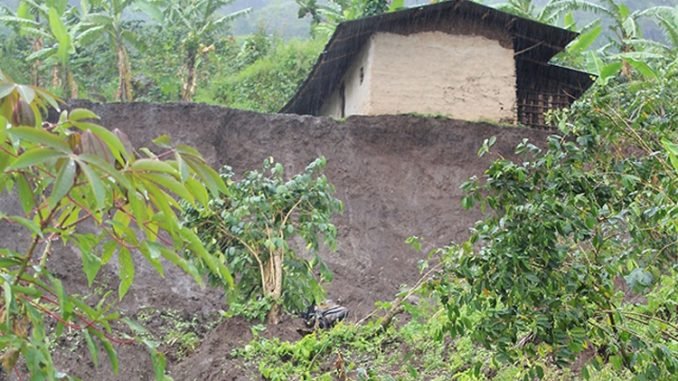
Bulambuli, Uganda | By Andrew Green | Mount Elgon’s residents are faced with a choice: stay or go? But both options have serious consequences.
The rains that have pounded Mount Elgon these past three months have devastated Mike Wogigona’s neighborhood in eastern Uganda’s Bulambuli District.
A tree perched on a hill above his neighbor’s house slid down an embankment in a heavy storm a few weeks ago. It came to rest diagonally next to their front door. Boulders wider than cars have been dislodged and now sit precariously on the few spots of flat land in this hilly region. And a network of cracks zigzag across the district, belying much deeper rifts in the soil and threatening an imminent collapse.
Wogigona’s house now stands at the edge of a newly formed cliff. And with every rainstorm, the edge of the cliff gets a little bit closer. “We’re at God’s mercy,” he said.
Wogigona and all of the residents living on the eastern side of Mount Elgon are facing an ongoing crisis. Over the last two years, mudslides have devastated the region, killing hundreds. But short of an extensive relocation effort, the death toll will continue to rise as each rainy season brings new slides. Wogigona worries that his village might go next.
In the absence of promised government assistance to relocate, residents have begun moving themselves – leaving their ancestral homes and their farmland in order to save their own lives, but with no place to go and no jobs waiting for them.
Stay or go? Mudslide or financial desperation? As the rains continue, that’s the choice that faces the people of Mount Elgon.
Most of the land on the eastern face of Mount Elgon is overpopulated and over farmed, according to a report from the National Environment Management Authority (NEMA). Subsistence farmers – the majority of people living in the area – have chopped down the trees that hold the soil in place.
“In most of the areas, people are just here,” said Kevin Nabutuwa Busima, the assistant director of disaster management at the Uganda Red Cross Society. “Most of the soil is now loose. Whenever it rains heavy, the soil gives way and then it just starts coming down.”
The result is death, but also complete disruption of the lives of survivors. Schools, roads and farmland have been destroyed on the slopes and disease has threatened as sanitation dwindles. There has been a recent rise in malaria cases, according to Red Cross officials.
Residents praise the reaction of the government and NGOs in providing survivors with food and water after the mudslides and offering coffins to bury the dead, but there is little evidence of anything being done to proactively address the problem.
The NEMA report faulted sub-county and district government officials for not making recommendations to mitigate the problem. And following an August mudslide that killed at least 24 people in Bulambuli, Moses Ecweru, the state minister for relief and disaster preparedness said the government simply did not have the funds to respond to all of the country’s natural disasters, let alone take steps to prevent them.
Even with unlimited money, preventing future mudslides is no easy task. More trees can be planted to try and gird the soil – an initiative various agencies and government officials have encouraged and some residents of the Bulambuli District said they have tried. And NEMA calls for stronger family planning initiatives to ease further pressure on the mountain and for more sustainable farming techniques to be introduced.
But the bottom line is people are going to have to move. The slopes of Mount Elgon simply cannot sustain the number of people who are living there.
According to the Bulambuli district council, at least 50,000 people in that district alone need to be moved. But so far the relocation money has not been forthcoming, despite promises as recently as last month by Ecweru. Representatives from the ministry for disaster preparedness declined interview requests for this story.
“Government has not planned for it,” said Woginina. “They tell us to be patient as government plans.”
In the meantime, all local government and Red Cross officials can do is respond to immediate needs for food and medicine and hope that the rains end soon.
“I think it will continue getting worse, because it is still raining,” said Agnes Mukoya, the manager of the Uganda Red Cross Society’s Sironko branch. “Until it stops raining, that’s when we can safely say the situation has normalized.”
Woginina cannot wait for the situation to normalize. He said at least 90 percent of the families in his village had already packed up and moved – his included – even without government assistance. He had lived in the area for 46 years – his entire life – but the knowledge that each rainstorm brought possible homelessness or death had convinced him it was time to go.
Stephen Botto almost waited too long. Botto has lived in a village a short distance from Woginina for 48 years and he can recall landslides in his area from as far back as 1988. But it was only after mudslides swept away the homes on both sides of him, killing 13 people, that he decided it was time to go.
For three days leading up to 28 August, he said his village was pelted with heavy rains.
“It went from morning up to sunset,” he said. “And then throughout the whole night. We heard noises made from these hills. Things falling… Some of us imagined this could be the end of the world.”
At one in the morning, three of his neighbors banged on his door and told him that “our friends have died.”
He took his cell phone flashlight and went to investigate. The house to one side had been moved 20 meters from its original position and was covered by mud. All nine people who had lived there were dead. The house on the other side had completely disappeared, along with the family inside of it.
Botto moved the next day.
The road to his old village was only recently rebuilt. It veers slightly from its original course – the original path is still strewn with the remains of houses and shelters that were destroyed in the slide. He told his story in the middle of a light rain, under the thatched awning of his house, which had somehow survived.
“I only come here to feed my animals,” he said. He is renting a home in a village at the base of the mountain “and we’re not going to come back.”
Like many of his neighbors, he is nervous about the decision to leave. Without government assistance, the rental house is straining his resources. He still has animals, but his matooke and coffee farms were destroyed by the slide. Relief agencies have been helping his family out with food, but sometimes they do not make it and he goes hungry.
Botto said he is afraid he might have traded one potential disaster for another – the speed of a mudslide for a slow decline into financial ruin. He has already pulled his children from school because he can no longer afford the school fees.
The number of people like Botto and Woginina who have been displaced is not easily documented. Many disappear from the region in search of family that can take them in. Others leave and return once the rains stop. But as Woginina walks around his neighborhood, he points to house after house that have been boarded up and abandoned.
“People are scared of incidents,” he said. “But now we must look for land to settle all of these people.”
Botto has listened to the government’s relocation promises and still holds out hope that it will happen. But he said he is worried that if he is finally moved, it will be to a region far away that he is not used to.
“I want [government] to buy us land in places that we feel very willing to go,” he said. “Provided they can give us land where we want, we are all willing to go.”



